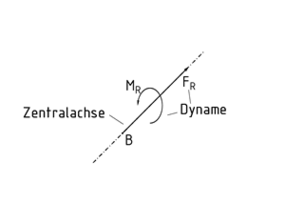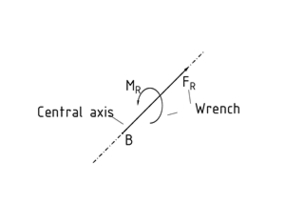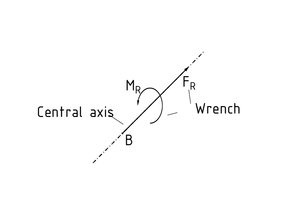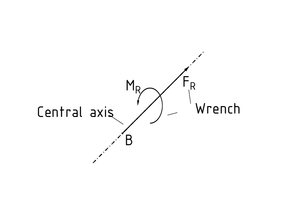
Wählen Sie eine
oder mehrere Sprachen aus
0,1,0
- Deutsch
- Englisch
- Chinesisch
- Spanisch
Dyname

Eine Dyname ${{\overrightarrow{F}}_{R}}$ bzw. ${{\overrightarrow{M}}_{R}}$ fasst dreidimensional gerichtete Kräfte bzw. Momente in einem Vektor zusammen.
Bevor eine Reduktion der Kräfte auf eine Dyname vorgenommen werden kann, müssen die resultierenden Kräfte bzw. Momente je Raumrichtung (x, y, z) ermittelt werden. Vorhandene Einzelkräfte werden dazu unter Berücksichtigung des jeweiligen Versatzmomentes auf einen Koordinatenursprung bezogen und für die drei Raumrichtungen vektoriell addiert. Daraus folgen schließlich${{F}_{Rx}}$, ${{F}_{Ry}}$, \[{{F}_{Rz}}\] (bzw.${{M}_{Rx}}$, ${{M}_{Ry}}$, \[{{M}_{Rz}}\]).
Die Resultierende dieser drei Kräfte bzw. Momente heißt Dyname. Sonderfall einer Dyname ist eine Kraftschraube (auch: Kraftwinder), bei der Kraft- und Momentvektoren parallel gerichtet sind. Bezogen auf den Punkt B liegt die Kraftschraube auf der sogenannten Zentralachse.
Wrench

A wrench ${{\overrightarrow{F}}_{R}}$ or ${{\overrightarrow{M}}_{R}}$ combines three-dimensionally oriented forces and/or moments in a single vector.
Before forces can be reduced to a wrench, the resultant forces / moments must be determined for each direction in space (x, y, z). To do so, individual forces present are assigned to an origin of coordinates, taking into account the relevant Offset moment, and added vectorially for the three directions in space. This ultimately produces ${{F}_{Rx}}$, ${{F}_{Ry}}$, ${{F}_{Rz}}$ (or${{M}_{Rx}}$, ${{M}_{Ry}}$, ${{M}_{Rz}}$).
The resultant of these three forces / moments is called a wrench. One special type of wrench is a Force screw, where the vectors of force and moment are parallel. In relation to the point B, the force screw lies on what is known as the central axis.
力螺旋

力螺旋 ${{\overrightarrow{F}}_{R}}$或${{\overrightarrow{M}}_{R}}$ 具有三维的定向力或单矢量力矩。
在力被减到一个力螺旋之前,空间任意方向(x, y, z)的合力或力矩应先被确定。为此在考虑到相关的偏心力矩的同时,存在的每个分力应被移动到坐标系的原点位置并矢量性地加入到三维空间中。最终结果是 ${{F}_{Rx}}$ 、 ${{F}_{Ry}}$ 、 ${{F}_{Rz}}$ (或 ${{M}_{Rx}}$ , ${{M}_{Ry}}$ , ${{M}_{Rz}}$ ).
这三个力或力矩的合力被称作力螺旋。力旋量是一种特殊形式的力螺旋,它的力矢量和力矩是平行的。以B点为参照,力旋量位于已知轴线上。
力旋量是力螺旋的一种形式
Llave

Una llave ${{\overrightarrow{F}}_{R}}$ o ${{\overrightarrow{M}}_{R}}$ combina fuerzas o momentos orientados tridimensionalmente en un vector único.
Antes de que se puedan reducir las fuerzas en una llave, los momentos de las fuerzas / resultantes deben ser determinados para cada dirección en el espacio (x, y, z). Para hacerlo, las fuerzas individuales presentes son asignadas a un origen de coordenadas, tomando en cuenta el momento de desplazamiento relevante y se agrega vectorialmente para las tres direcciones en el espacio. Esto finalmente produce ${{F}_{Rx}}$, ${{F}_{Ry}}$ , ${{F}_{Rz}}$ (o ${{M}_{Rx}}$ , ${{M}_{Ry}}$ , ${{M}_{Rz}}$ ).
El resultado de estos tres momentos de fuerzas / se llama llave. Un tipo especial de llave es un tornillo de fuerza, donde los vectores de fuerza y de momento son paralelos. En relación con el punto B, el tornillo de fuerza descansa en lo que se conoce como el eje central.
Tornillo de fuerza como una forma de llave
